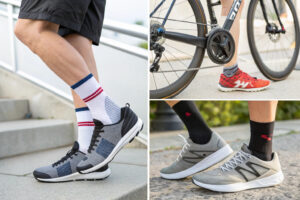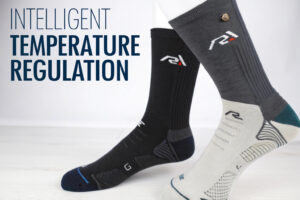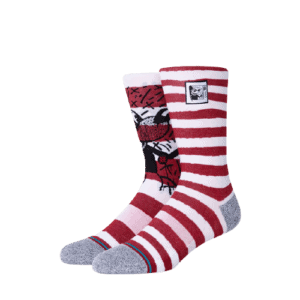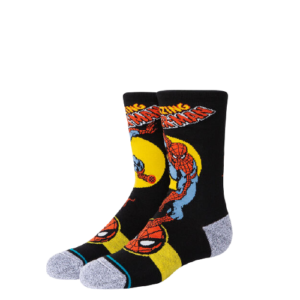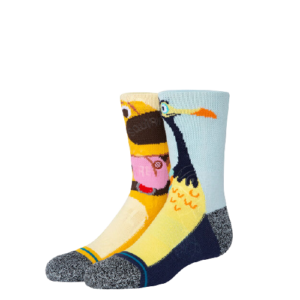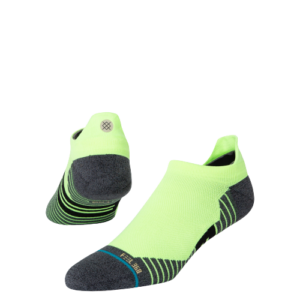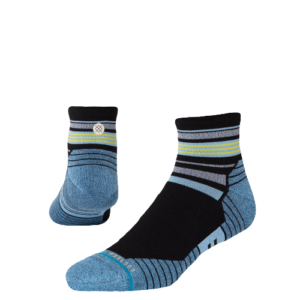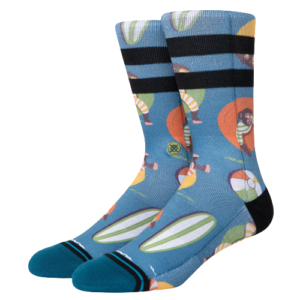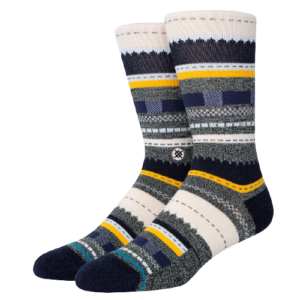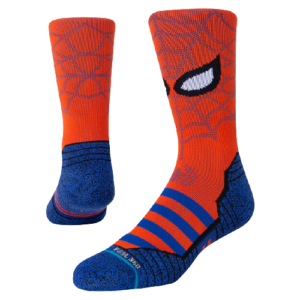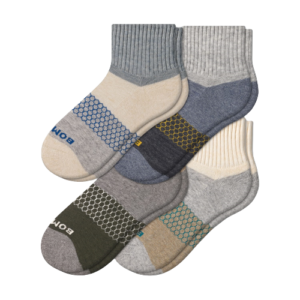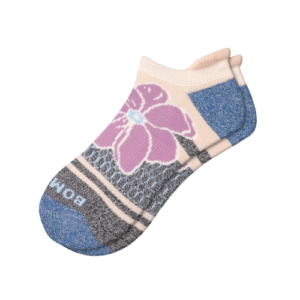As a leading socks manufacturer in China's textile hub, Keqiao, I've seen many trends come and go. But one of the most surprising and rapidly growing trends in recent years is the demand for refrigerated socks, especially from buyers in hot climate regions like the Southern United States, Middle East, and Australia. If you're a procurement specialist like Ron, you might be wondering if this is just a gimmick or a genuine solution to a serious workplace problem. The answer lies at the intersection of worker safety, advanced textile technology, and smart business logistics.
Refrigerated socks are trending because they directly address the critical need for enhanced worker safety and comfort in extreme heat, leading to increased productivity and reduced heat-related illnesses for construction teams. This isn't just a novelty; it's a functional application of cooling textile technology that integrates moisture-wicking fabrics, phase-change materials (PCMs), and breathable constructions to create a micro-climate for the feet. For buyers, this represents a high-value product category with significant ROI, blending worker welfare with operational efficiency.
Let's dive into the reasons behind this trend and explore how, as a wholesale supplier, we've adapted our production to meet this specific and growing global demand.
How Do Refrigerated Socks Actually Work?
The term "refrigerated" can be misleading. These socks don't have a mini-compressor. Instead, they use sophisticated textile science to create a lasting cooling sensation. For buyers focused on quality and innovation, understanding the mechanism is key to validating the product's value and explaining it to your own customers.
The core technology often involves phase-change materials (PCMs). These are smart materials that absorb, store, and release heat energy. When the worker's foot temperature rises, the solid PCM microcapsules embedded in the sock's fibers melt, absorbing excess heat and creating a cooling effect. When the foot cools down, the material solidifies again, releasing the stored heat. This creates a dynamic, self-regulating temperature buffer. This is a prime example of the high-performance fabrics we specialize in at GlobalSock, developed in our CNAS-certified lab to ensure consistent and reliable performance.

What Are the Key Technologies Inside These Socks?
Beyond PCMs, refrigerated socks are a symphony of integrated technologies. The cooling effect is rarely achieved by a single feature; it's the result of a synergistic design. Firstly, the base fabric is crucial. We use advanced moisture-wicking blends like bamboo viscose and recycled polyester. These materials pull sweat away from the skin rapidly, and as the moisture evaporates, it provides an additional cooling effect. This is paired with breathability achieved through mesh ventilation panels in critical areas like the instep and ankle, promoting constant air circulation within the boot.
Secondly, the construction is designed for temperature regulation. Many of our models for this category combine PCMs with other advanced yarns. For instance, incorporating Coolmax® or Tencel™ fibers enhances the moisture management and adds a silky, soft & comfortable feel that reduces friction—a critical factor in blister prevention. The combination of these technologies ensures the sock doesn't just feel cool initially but maintains a comfortable microclimate throughout the work shift, directly addressing the pain point of timeliness and long-lasting performance.
Who Benefits Most from Wearing Refrigerated Socks?
While any outdoor worker in a hot climate can benefit, the primary beneficiaries are those in high-exertion, safety-critical roles. Construction workers are the most obvious group, as they often wear heavy, non-breathable safety boots for long hours on hot surfaces. Similarly, road crews, miners, and warehouse logistics personnel operating in non-climate-controlled environments see a dramatic improvement in comfort. The secure fit / non-slip design of these socks is also vital, ensuring they stay in place inside the boot during intense movement, which is a key part of blister prevention.
Another significant group is workers who are required to wear fully encapsulating protective gear, such as in certain chemical or industrial plants. For these users, the antibacterial & odor-control properties are not just a comfort feature but a necessity for hygiene and skin health over long shifts. By preventing maceration (the softening and breaking down of skin due to moisture), these socks directly contribute to durable & long-lasting foot health and reduce downtime due to medical issues.
What Are the Tangible Benefits on the Construction Site?
The trend isn't driven by marketing alone; it's backed by measurable outcomes that impact a company's bottom line. For a buyer like Ron, who balances quality with price, demonstrating a clear return on investment is essential for making the case to his management or clients.
The most significant benefit is the reduction in heat-related illnesses. Conditions like heat exhaustion and heat stroke are serious risks on construction sites. By helping to regulate core body temperature through the feet—a key area for heat exchange—these socks can reduce the overall thermal strain on a worker's body. This leads to a safer work environment, fewer accidents, and lower insurance costs. Furthermore, a comfortable worker is a more productive worker. When feet are cool and dry, workers experience less fatigue and can maintain focus and energy levels for longer, directly enhancing productivity and project timeliness.

How Do They Improve Worker Safety and Health?
The direct health benefits extend beyond general heat stress. A primary issue in hot environments is excessive sweat, which leads to a moist environment inside the boot. This is the perfect condition for blisters, fungal infections, and trench foot. The moisture-wicking and quick-drying properties of high-quality refrigerated socks keep the skin remarkably dry. This, combined with arch support and a seamless toe / reduced bunching design, drastically minimizes friction points. The result is a significant reduction in blisters and skin irritations, which are common causes of discomfort and lost workdays.
Moreover, the antibacterial & odor-control feature, often achieved through silver-ion or copper-infused yarns, inhibits the growth of bacteria and fungi. This not only keeps the socks fresher for longer, making them more easy care for the user, but also promotes long-term foot hygiene. For a procurement manager, this translates into fewer worker complaints, lower demands for first-aid supplies, and a demonstrable commitment to worker welfare, which can boost morale and reduce turnover.
What Is the ROI for Project Managers and Buyers?
From a financial perspective, the investment in premium refrigerated socks pays for itself multiple times over. Let's break down the return on investment (ROI):
| Benefit | Financial Impact |
|---|---|
| Reduced Absenteeism | Fewer sick days taken due to heat stress or foot problems. |
| Increased Productivity | Workers maintain a higher output for longer periods without fatigue. |
| Lower Insurance Premiums | A safer worksite with fewer incidents can lead to reduced liability and health insurance costs over time. |
| Enhanced Worker Retention | Investing in worker comfort reduces turnover, saving on recruitment and training costs. |
| Faster Project Completion | Improved productivity and fewer delays help meet deadlines, avoiding penalty clauses. |
When you present this data alongside the actual product cost, it becomes clear that this is not just an expense but a strategic investment. Our agile supply chain allows us to produce these high-performance socks at a scale and speed that makes this ROI accessible, with quick bulk delivery ensuring your projects don't face delays.
How to Source Quality Refrigerated Socks from China?
Sourcing a technical product like this requires a supplier with proven expertise, not just a generic socks factory. You need a partner who understands the material science, possesses the right certifications, and has a robust logistics framework to ensure timely and secure delivery to the U.S., mitigating concerns like tariff costs and sailing schedules.
The first step is to verify the manufacturer's technical capabilities. Ask for details about the PCMs they use: what is the melting point? (Typically 28-32°C is ideal for human comfort). How many washing cycles does the cooling effect last? Our CNAS-accredited testing center rigorously checks these parameters, and we provide real-time access to composition and performance data via QR code tracking, guaranteeing a 98% client pass rate. This level of quality control is non-negotiable for a product whose value depends on its functional longevity.

What Quality Certifications Should You Look For?
Certifications are your objective proof of quality and safety. For refrigerated socks, look beyond basic business licenses. Key international standards to look for include:
- OEKO-TEX® Standard 100: certifies the textiles are free from harmful substances, ensuring they are hypoallergenic and non-irritating.
- ISO 9001: demonstrates a robust Quality Management System in the factory.
- GRS (Global Recycled Standard): if the socks use recycled polyester, this certification tracks the recycled content.
- Specific Performance Test Reports: for claims like UV protection (UPF), abrasion & pill resistant, and compression levels, the supplier should provide test reports from accredited labs like our CNAS facility.
These certifications are not just pieces of paper; they are a supplier's commitment to consistent quality and a safeguard for your brand reputation. They directly address the pain points of quality control and security in the supply chain.
How Can You Navigate Logistics and Tariffs Efficiently?
A common pain point for American buyers like Ron is navigating the complexities of logistics and tariff costs. A seasoned Chinese supplier will have strategies to mitigate these issues. At GlobalSock, we leverage our position in the "Silk Road Keqiao" initiative and diversified market approach to offer optimized shipping solutions. We consolidate orders to reduce costs and utilize our overseas warehousing partnerships to streamline customs clearance.
Crucially, our product strategy can help mitigate tariff impacts. By focusing on innovation and eco-friendly / sustainable materials (like recycled fabrics and organic cotton), many of our socks may fall under different, potentially more favorable, tariff classifications than standard commodity socks. Our financial stability, backed by strategic banking partnerships, also allows us to offer flexible payment methods, providing you with security and cash flow flexibility for your bulk orders.
Are Refrigerated Socks a Sustainable Choice?
In today's market, a product's appeal isn't just about function; it's also about its environmental and social impact. Buyers and end-consumers are increasingly making choices based on sustainability credentials. The good news is that the refrigerated socks trend is fully compatible with a green agenda.
The very technologies that enable high performance are evolving to be more sustainable. For instance, the moisture-wicking base fabrics we use are increasingly made from bamboo socks (a rapidly renewable resource) or recycled polyester derived from post-consumer plastic bottles. Our eco-friendly innovations extend to the PCMs themselves, with ongoing R&D into bio-based alternatives. This commitment is part of our larger ¥550M green investment, aligning with UN SDGs and making it easier for you to market these socks as a responsible choice.

What Eco-Friendly Materials Are Used?
The shift towards natural fibers and recycled materials is central to the evolution of performance socks. We offer refrigerated socks constructed from:
- Bamboo Viscose: Known for its natural breathability, softness, and antibacterial properties. It's a fantastic, sustainable base for cooling socks.
- Recycled Polyester (rPET): Provides excellent moisture-wicking and durability while diverting plastic waste from oceans and landfills.
- Organic Cotton Socks: For blends that require a natural feel, GOTS-certified organic cotton ensures no toxic pesticides or fertilizers are used.
By choosing a supplier that prioritizes these materials, you are not only getting a high-performance product but also contributing to a circular economy. This is a powerful marketing angle, especially in the European market where EU eco-certifications are highly valued.
How Does This Align with Corporate Social Responsibility (CSR)?
Procuring refrigerated socks made with sustainable materials and ethical production practices is a direct action that bolsters your own company's CSR profile. It shows a commitment to the well-being of both the end-user (the worker) and the planet. This aligns with the values of many large corporations and government tenders which now have strict sustainability criteria for their suppliers.
Furthermore, by investing in worker safety through a product that also has a lower environmental footprint, you create a powerful narrative of holistic responsibility. It demonstrates that cost-effectiveness and worker productivity do not have to come at the expense of environmental stewardship. This strategic alignment can be a key differentiator for your business in a competitive market.
Conclusion
The trend of refrigerated socks for hot climate construction workers is far more than a passing fad. It is a data-driven response to a critical workplace challenge, powered by advancements in textile technology and a growing emphasis on worker welfare and sustainability. From their sophisticated PCM-based cooling mechanisms to their tangible benefits in safety, productivity, and ROI, these socks represent a smart and responsible choice for forward-thinking procurement professionals.
If you are looking to source high-quality, reliable, and competitively priced refrigerated socks, partnering with an experienced manufacturer is crucial. We at GlobalSock have over a decade of expertise in producing advanced functional socks, supported by our CNAS-certified lab, agile R&D team, and robust global logistics network. We are ready to help you develop and supply the perfect socks for your market.
Ready to explore how refrigerated socks can benefit your business and your clients? Contact our Business Director Elaine at elaine@fumaoclothing.com to discuss your specific needs and start your own socks production order with a trusted partner in Asia.



